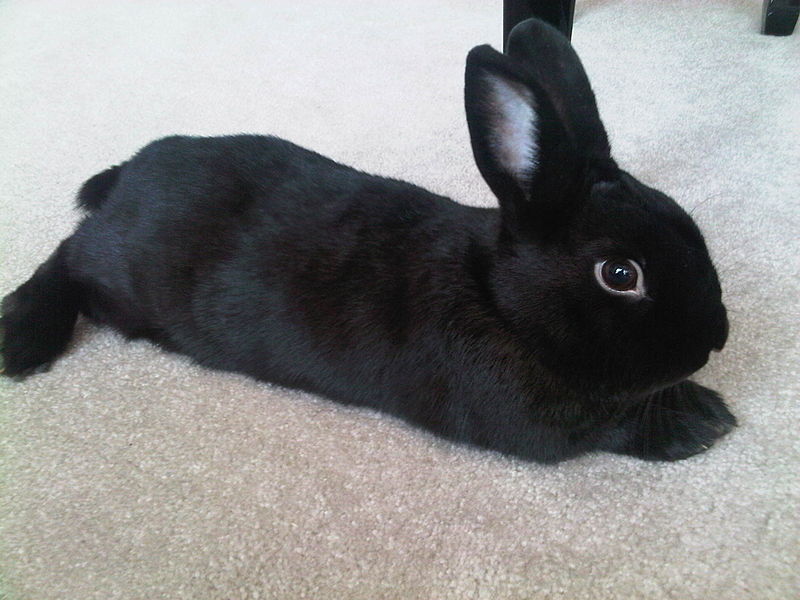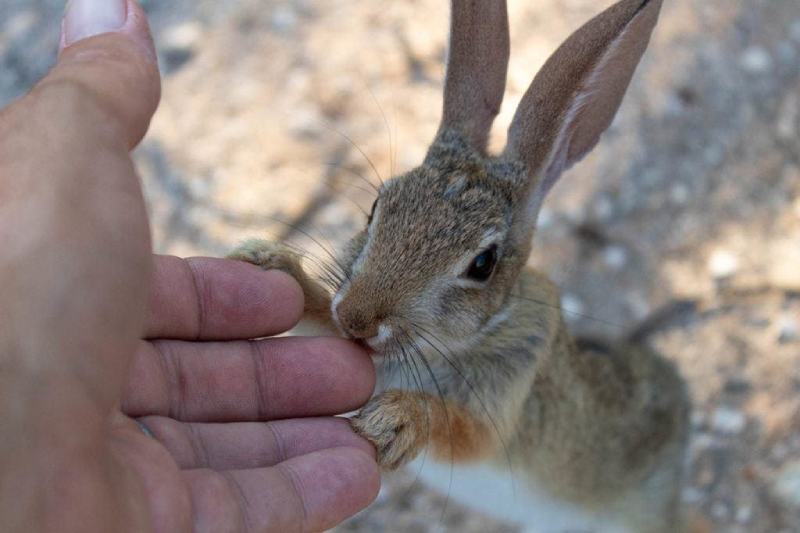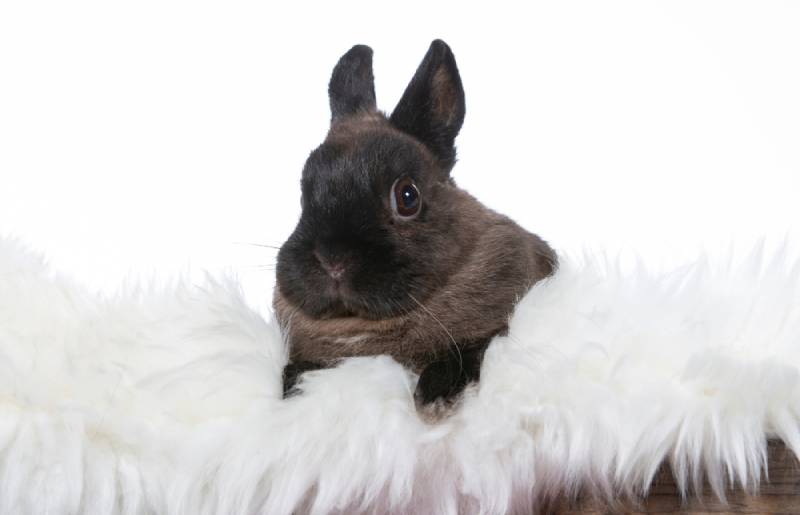English Spot Rabbit: Pictures, Care Guide, Lifespan & Traits
Updated on
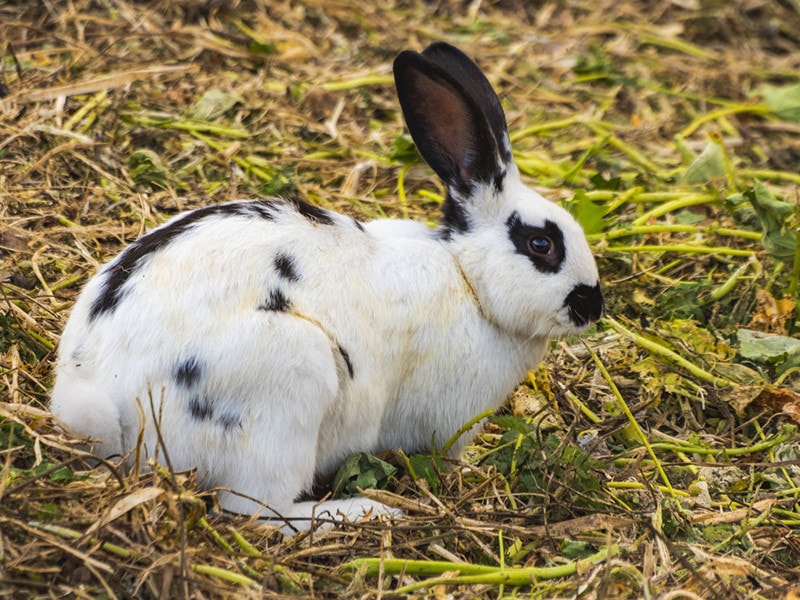
Click to Skip Ahead
The English Spot rabbit breed is a very beautiful and popular breed that is known for their unique patterning and wonderful temperament. They have been around for quite a while and unlike most other breeds, were developed specifically as show rabbits.
Also known as the Lapin Papillon Anglais in French, they are recognized by both the American Rabbit Breeders Association and the British Rabbit Council. These adorable, lovable bunnies have plenty to offer rabbit owners so keep reading to learn more about this incredible breed and what they are all about.
| Size: | Medium |
| Weight: | 5 – 8 pounds |
| Lifespan: | 6 – 8 years |
| Similar Breeds: | Checkered Giant |
| Suitable for: | Individuals, families with children, seniors |
| Temperament: | Friendly, inquisitive, active, engaging |
The English Spot rabbits is a medium sized breed that reaches between 5 and 8 pounds when fully grown. While they are significantly smaller, they are similar in appearance to the Checkered Giant. They have short, soft coats that have a unique patterning that includes a butterfly nose marking, circles around the eyes, spots on the cheek, herringbone, and a series of spots on the body.
There are several different color variations of the English Spot including black, lilac, chocolate, blue, tortoise, gray, and golden. These rabbits are known for their excellent temperaments and make friendly, active, curious, but gentle pets. The breed lives an average of 6 to 8 years with proper care and are suitable for all experience levels.
English Spot Rabbit Characteristics
 How Much Do These Rabbits Cost?
How Much Do These Rabbits Cost?
The cost to purchase an English Spot Rabbit typically ranges between $10 and $50, with the most expensive being those that are show quality. The price will still vary among show rabbits and will be dependent on the breeder, the rabbit’s pedigree, and the specific coat color.
Temperament & Intelligence of the English Spot Rabbit
Because the English Spot was originally developed as a show rabbit, they are typically very docile, gentle, and easy to handle. When properly socialized, they will often enjoy human interaction and will gladly accept petting, handling, and play.
They are highly intelligent and can be trained with positive reinforcement techniques. They are quite curious and active, so they do require some physical and mental stimulation to keep them from becoming bored and possibly turning to more destructive behaviors.
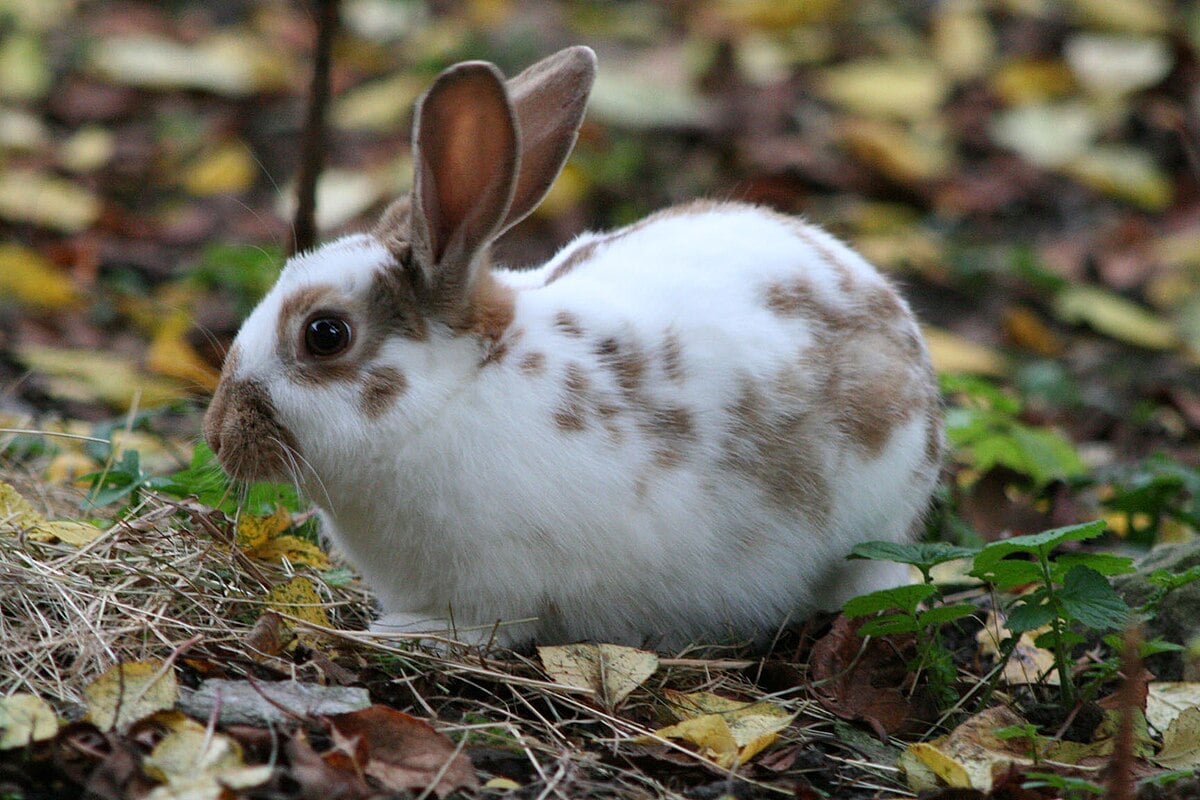
Do These Rabbits Make Good Pets? 👪
English Spot rabbits can make excellent pets for families that are prepared to take on the responsibility of owning a rabbit. Since they are typically friendly and docile, they make great options for first time rabbit owners and owners of all experience levels.
Does This Rabbit Get Along With Other Pets?
With their laid-back personality, English Spot rabbits typically get along very well with other rabbits, though it’s best to have everyone spayed and/or neutered to prevent any territorial behavior or unwanted litters.
When it comes to other pets in the household, owners should always take caution. Rabbits are prey animals that are often fearful of other pets. It’s also very easy for them to be injured or even killed by other family pets, especially dogs.
Other pets should be socialized to rabbits from an early age to prevent prey drive instincts. Introductions should be done slowly so as not to make the rabbit uncomfortable. Interactions with other pets should always be heavily supervised.
Things to Know When Owning an English Spot Rabbit
Food & Diet Requirements 🥕
Just like any other rabbit, the English Spot should always have access to high quality grass hay like Timothy, orchard grass, oat or oat blend and more. Hay is an essential part of a rabbit’s diet and will account for the majority of what they consume. Not only is it needed for proper digestion, but also to naturally wear their continuously growing teeth.
While young rabbits can munch on hays higher in protein and calcium such as alfalfa hay, this should not be the primary hay source for an adult rabbit as the high concentration of protein and calcium can have adverse health effects.
The English Spot should also be fed a commercial pellet food designed for rabbits. The daily amount to offer will depend on the rabbit’s age, size, and activity level and owners should follow the manufacturer’s instructions. Moderate amounts of leafy greens, fresh vegetables, and fruit should also be offered to provide the English Spot a varied, nutritious diet.
Always ensure that the fresh foods you are offering are safe for rabbits and in the appropriate quantity. Questions regarding your English Spot rabbit’s diet should always be directed to your veterinarian.
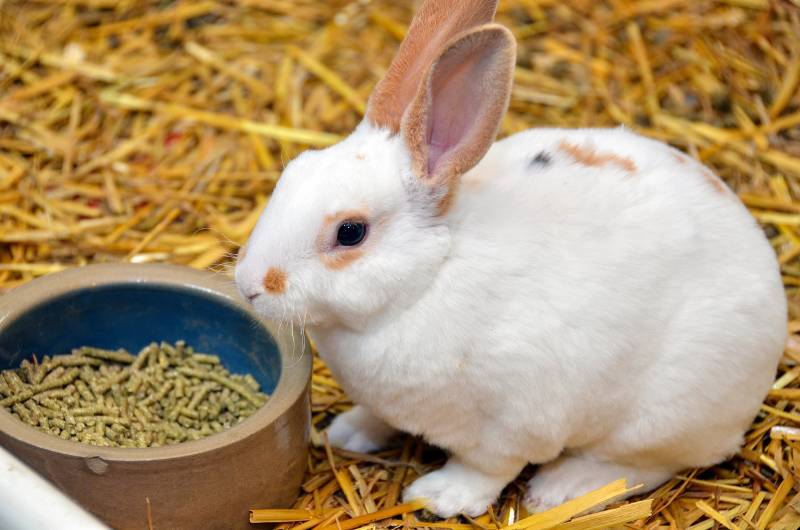
Habitat & Hutch Requirements 🏠
English Spot rabbits will require an appropriately sized, comfortable home will help keep them happy and healthy. There are plenty of options available to house rabbits both indoors and outdoors including cages, premade condos, secure pens, and rabbit hutches.
You’ll have to decide which option suits your situation best, but regardless of which type of housing you go for, it should always be kept clean and meet the following criteria:
Secure and Safe from the Elements
Whether you keep your rabbits indoors or outdoors, they should always have a secure, well-ventilated shelter where they are safe from the elements, other pets or predators, and can feel safe and comfortable enough to rest and sleep.
Plenty of Space
Rabbits are active creatures that are going to need plenty of room to hop, run, stretch out when sleeping, jump, dig and indulge in natural rabbit behaviors in the comfort of their enclosure. Their housing should also be high enough that they can stand up on their back legs without their ears touching the roof of the enclosure.
Safe Bedding with Hiding Areas
Your English Spot is going to need safe, comfortable bedding to line their enclosure and since they are prey animals by nature, you should always provide them with hiding places like a box, den, or a hide to make them feel safe and secure.
Bathroom Area
Your rabbit should always have a space within their enclosure to relieve themselves. Whether it be a litter tray, newspaper, or an area of straw or hay, you should make sure this bathroom space is always accessible and separate from where they sleep.
Exercise & Sleeping Needs 🐇
The English Spot rabbit is an active breed and will require 3 to 4 hours of daily exercise to keep them as happy and healthy as possible. You should set aside time to let your rabbit out of their cage where they can explore and play under your supervision. You can also provide them with plenty of stimulating toys and even buy or make your own rabbit tunnels.
Rabbits are most active in the early morning, dusk, and at night and will spend approximately 12 to 14 hours a day sleeping. Since they’ll have plenty of downtime, they should have a safe environment where they can sleep comfortably and quietly during the day.
Training 🥎
English Spots are incredibly intelligent and can be trained to do various things like fetch, agility, and even jump or spin around on cue. Like with any pet, training your rabbit will take time, patience, and consistency, so it’s always best to start when they are young.
Since rabbits learn best during play, it’s a good idea to keep some healthy treats on you to reward them during the process. Remember they are prey animals and should be trained in a safe, comfortable environment that is free from distractions.
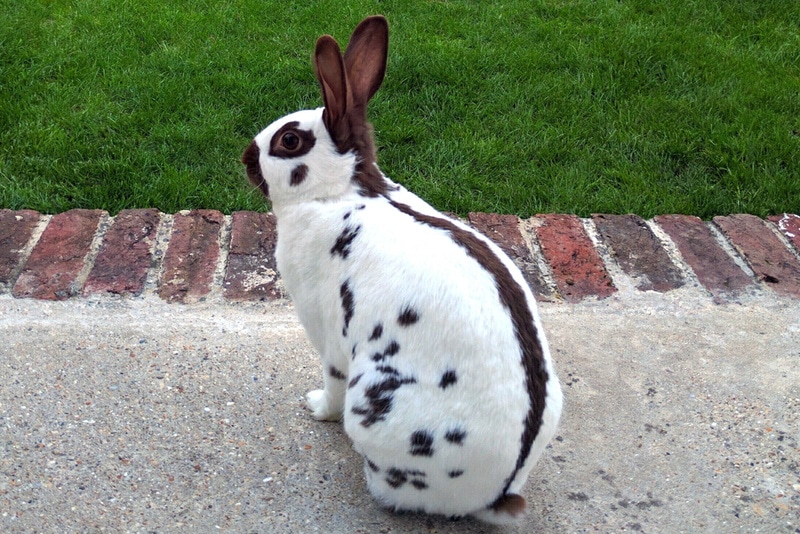
Grooming ✂️
The English Spot has a relatively short coat that is easy to care for. It’s a good idea to gently brush them out about once per week and make sure to trim their nails to prevent them from growing too long. Try to get them accustomed to brushing and nail clippings starting as early as possible, as this will make them more tolerant and comfortable during the process.
Lifespan and Health Conditions 🏥
The English Spot rabbit has an average lifespan of 6 to 8 years if they receive proper care and husbandry. It’s important to keep them in a clean, safe environment, feed them a balanced, nutritious diet that is appropriate for their age and size, and ensure they get plenty of daily exercise.
Like any rabbit, however, the English Spot is susceptible to certain health conditions that owners should be aware of. It’s important to understand what kind of health ailments could affect your rabbit, what signs to look for, and always establish care with a veterinarian for the sake of your rabbit’s health.
- Parasites
- Pododermatitis
- Gastrointestinal stasis
- Dental problems
- Uterine cancer
- Respiratory tract infection
Gastrointestinal (GI) Stasis
GI stasis refers to the slowing of passage of food through the gastrointestinal tract. Many things can lead to GI stasis including stress, lack of fiber, anorexia, dehydration, intestinal blockage, or other underlying health conditions. If left untreated, severe cases of GI stasis can be fatal, so if your rabbit shows any signs, they should be taken to the veterinarian right away.
Dental Problems
Dental problems are common in rabbits and can often be linked to an improper diet. A rabbit’s teeth grow continuously and can easily become overgrown if they are not eating enough coarse hay to wear them down naturally.
Overgrown teeth can range from mild to severe but must be dealt with to restore your rabbit’s health. Once they become overgrown, they can become very painful, abscess, and become infected.
Uterine Cancer
Studies have shown that as many as 60 percent of un-spayed female rabbits over 3 years of age develop uterine cancer. Because of this, female rabbits should be spayed as soon as possible. Unaltered females will typically develop benign changes in the uterus that eventually turn malignant over time and can spread through other parts of the body.
Respiratory Tract Infection
Snuffles, or respiratory infections, in rabbits are quite common and can pose a serious threat to your rabbit’s health. Since it is often hard to tell that a rabbit is not feeling well, the condition is often more serious once the signs are there. Respiratory infections can be especially problematic since a rabbit is unable to breathe through their mouth if their nose is stuffed. If you notice sneezing, congestion, nasal discharge, or conjunctivitis, it’s time to get your rabbit to the vet.
Parasites
The English Spot can be affected by both internal and external parasites such as fleas, ticks, pinworms, tapeworms, and more. Rabbits often don’t show signs of internal parasites right away, so it’s best to have them examined regularly by a veterinarian for their routine health exams.
Pododermatitis
If a rabbit’s normal stance is disturbed, it can lead to pressure sores on the base of the feet known as pododermatitis. This starts as a problem with the skin but can progress if left untreated, as it can affect deeply into the tissues and become painful and debilitating.
 Male vs Female
Male vs Female
It’s important to note that each rabbit is an individual and gender doesn’t necessarily determine their main personality traits. There are some generalizations that separate males and females by nature, however.
Male rabbits are often considered to be easier pets for first time owners, as they tend to have a calmer demeanor, are less territorial, and exhibit fewer destructive tendencies. That doesn’t mean females don’t make excellent pets, and with the friendly nature of the English Spot, both genders tend to be very pleasant.
Whether you have a male or female, it is important to have them spayed or neutered, not only to avoid unwanted behaviors related to sexual maturity and unwanted litters, but also for their overall health and wellbeing.
3 Little-Known Facts About the English Spot Rabbit
1. They Were Originally Bred for Show
The English Spot breed was developed in England in the nineteenth century through selective breeding with the purpose of using them for show. This is unlike other rabbit breeds that were primarily bred for fur or meat.
2. Their Origins Are a Mystery
While we know that the English Spot was developed in the United Kingdom during the 19th century, their true origin remains a mystery. They are believed to be among the oldest of the fancy rabbit breeds and while notably smaller, it is believed they are related to the Checkered Giant because of their similar physical characteristics.
3. They Entered America Around 1910
While the English Spot rabbit breed has been common in the UK since the 1860s, they weren’t imported into America until about 50 years later around 1910. By 1924, a breed club called the American English Spot Rabbit Club was established.
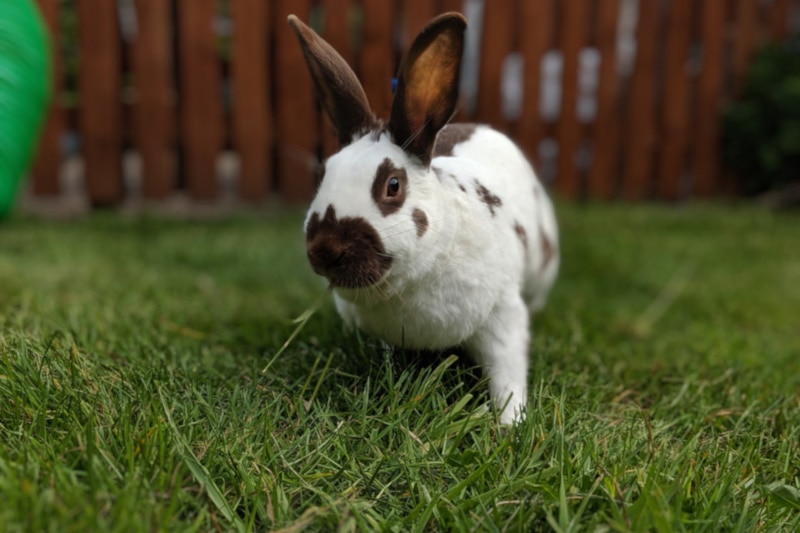
Final Thoughts
Renowned for their unique coat pattern, the English Spot are among the few rabbit breeds that were originally developed for show purposes rather than for meat or fur. The English Spot is a beautiful, friendly, and curious breed that can make excellent pets for rabbit owners of all experience levels. While they may be active, they are also very intelligent, trainable, docile, and easy to handle.
Featured Image Credit to: Wirestock Creators, Shutterstock
 How Much Do These Rabbits Cost?
How Much Do These Rabbits Cost?
